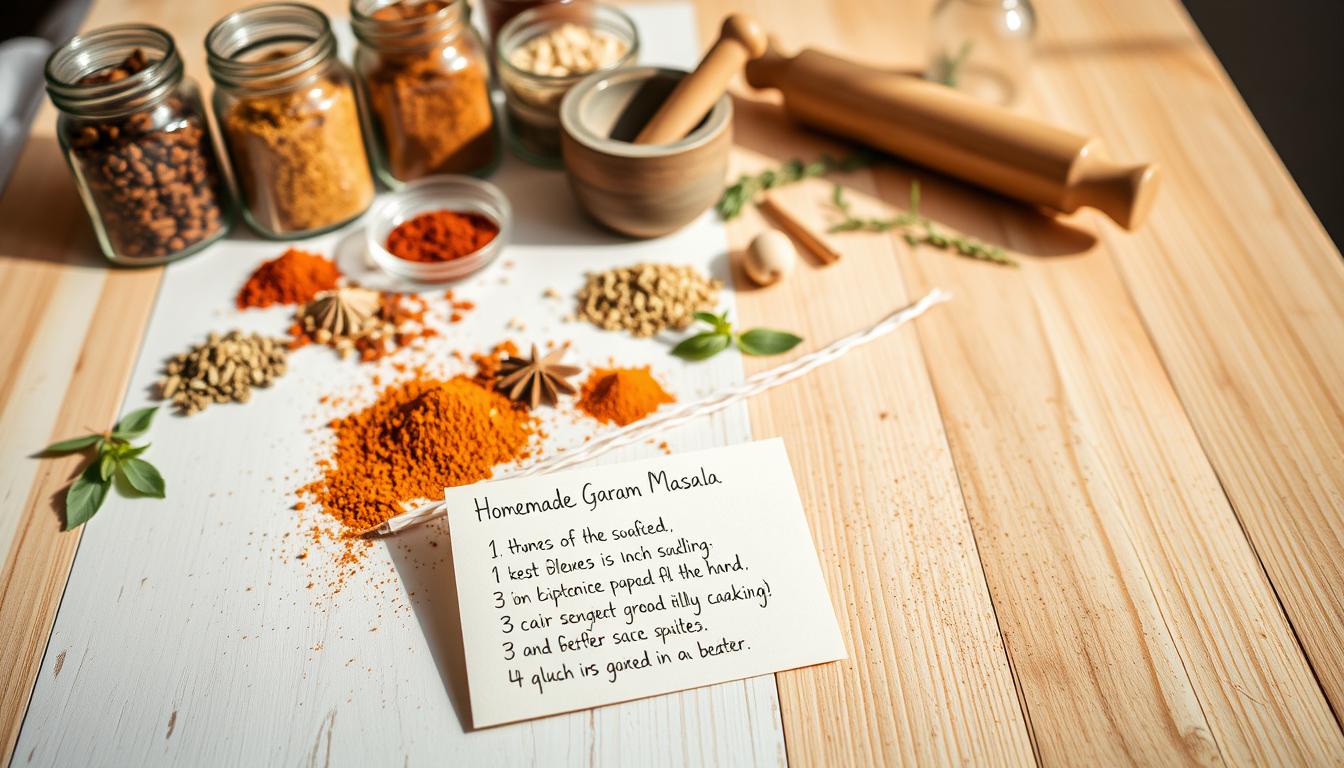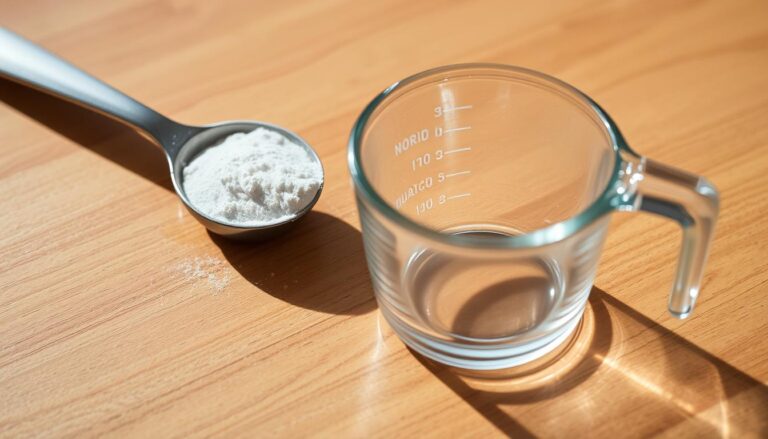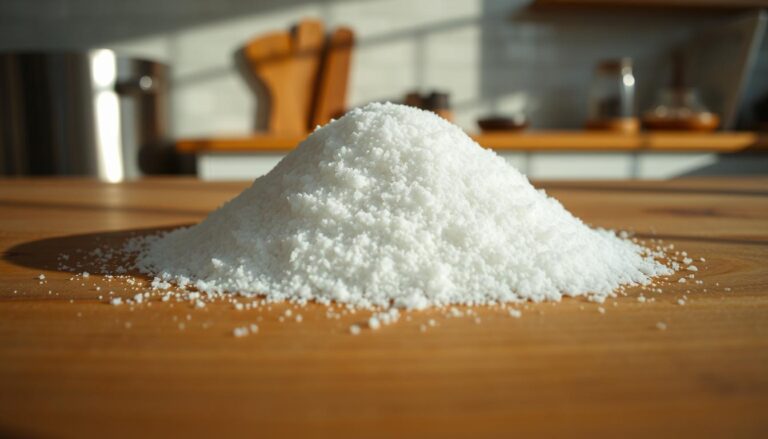Garam Masala: Elevate Your Cooking with This Aromatic Blend
Imagine unlocking rich, complex flavors that turn simple meals into restaurant-worthy dishes with just a pinch of one magical mix. Welcome to the world of garam masala—a fragrant spice blend celebrated across kitchens for its ability to add warmth and depth to countless recipes.

Rooted in Indian culinary traditions and Ayurvedic practices, this versatile combination has been perfected over centuries. Unlike store-bought versions, homemade garam masala offers unmatched freshness and customization. Whether you’re seasoning roasted vegetables or simmering curries, its toasted spices create a symphony of flavors you’ll want to savor.
This guide walks you through everything—from its fascinating history to crafting your own batch. You’ll learn how to select quality spices, toast them for maximum aroma, and store your blend to keep it vibrant. Ready to transform your cooking?
Key Takeaways
- Garam masala is a traditional Indian spice blend known for its warm, aromatic qualities.
- Homemade versions offer fresher flavors and customizable heat levels compared to pre-packaged options.
- The mix often includes spices like cumin, coriander, cardamom, and cloves.
- Proper toasting and grinding techniques are essential for unlocking its full flavor potential.
- Store your blend in an airtight container to preserve its potency for up to six months.
Introduction to Garam Masala
Picture a spice blend that instantly adds warmth to soups, depth to curries, and intrigue to roasted veggies. That’s the magic of garam masala—a fragrant mix celebrated in kitchens worldwide. Its name translates to “hot spices,” but don’t let that fool you. The heat here comes from gentle warmth, not fiery intensity.
At its core, this blend balances earthy, sweet, and citrusy notes. Common ingredients include:
- Cumin for nutty richness
- Coriander for bright freshness
- Cloves for peppery depth
What makes it special? Unlike single spices, garam masala layers flavors. It’s like having a flavor orchestra in your pantry. Chefs often add it at the end of cooking to preserve its aroma.
Store-bought versions work in a pinch, but homemade lets you control the taste. Want more smokiness? Toast the spices longer. Prefer subtle sweetness? Adjust the cardamom. Your kitchen, your rules!
Later, we’ll share simple steps to make garam masala at home. You’ll learn how to blend, store, and use garam masala in everything from lentil stews to grilled meats. Ready to cook smarter, not harder?
The History and Cultural Significance of Garam Masala
Centuries before modern kitchens, healers and cooks across India crafted blends to nourish both body and soul. Garam masala emerged from this tradition, with “garam” meaning “warming” in Hindi—a nod to its role in balancing internal heat according to Ayurvedic principles. Unlike curry powder, a British-colonial invention, this mix reflects regional diversity, with recipes shifting from Punjabi villages to Kerala coastlines.
Ayurveda views these spices as digestive aids that stoke metabolism. Cloves and fennel seeds, common in the blend, were prized for soothing stomachs and boosting circulation. Families often passed down their unique ratios, tweaking ingredients like black pepper or cinnamon based on local harvests and health needs.
What sets it apart? While curry powder leans on turmeric for color, garam masala focuses on toasted warmth. Its complexity comes from layering whole spices—coriander for citrusy notes, cumin for earthiness—then grinding them fresh. This approach preserves oils that lose potency when pre-packaged.
Today, making your own mix connects you to generations who saw spices as both flavor and medicine. Whether adding a pinch to soups or rubs, you’re tapping into a legacy where every sprinkle tells a story.
Essential Spices in Garam Masala
Every great spice blend begins with quality ingredients. The magic lies in balancing earthy, sweet, and warming notes through careful selection. Let’s explore the core elements that define this iconic mix and optional twists to make it your own.
Primary Spice Components
Cumin brings nutty earthiness, while coriander seeds add a citrusy freshness. Green cardamom pods offer floral sweetness, and cloves contribute peppery depth. Cinnamon sticks round it out with gentle warmth. Together, these spices support digestion and boost metabolism.
Toasting whole spices unlocks their oils. Heat a dry pan until fragrant—about 2 minutes. Let them cool before grinding into a fine powder. A coffee grinder works best for achieving that silky texture.
Optional Ingredients for Extra Aroma
Want to experiment? Try adding nutmeg for creamy richness or fennel seeds for licorice-like sweetness. Star anise introduces a bold, bittersweet note, while bay leaf adds subtle herbal complexity. These extras deepen flavors without overpowering dishes.
- Nutmeg: Enhances creamy sauces
- Fennel: Balances rich meats
- Star anise: Perfect for slow-cooked stews
Always clean spices with a dry cloth before roasting. Dust or debris can affect flavor. Store your custom blend in airtight containers to preserve its vibrancy for soups, marinades, or even baked goods!
Step-by-Step Garam Masala Recipe
Ready to create your own aromatic magic? Follow these simple steps to craft a fresh, vibrant blend that elevates soups, meats, and veggie dishes. The secret lies in technique—proper cleaning, precise roasting, and smart storage.
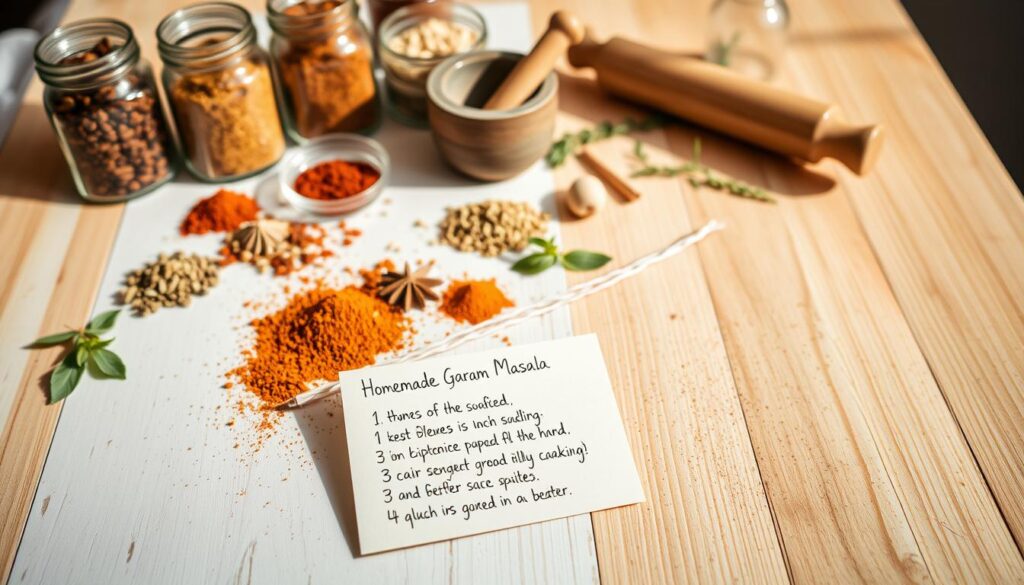
Cleaning and Roasting the Spices
Start by wiping whole spices like coriander seeds and fennel seeds with a dry cloth. This removes dust without washing away essential oils. For oven roasting:
- Spread spices on a baking sheet
- Heat at 200°F (40°C) for 8-10 mins
- Cool completely before grinding
Stovetop method? Use a skillet on low heat. Toast cumin and cinnamon sticks for 3-5 minutes until fragrant. Stir constantly to prevent burning!
Grinding, Measuring, and Storage Tips
Grind cooled spices in a powerful grinder. Pulse in 10-second bursts to avoid overheating. Aim for a fine powder—sift if needed for smooth texture.
Measurement matters:
| Spice | Amount | Purpose |
|---|---|---|
| Coriander | 2 tbsp | Citrus base |
| Cumin | 1.5 tbsp | Earthy depth |
| Cardamom | 1 tsp | Floral sweetness |
Store your mix in an airtight glass jar. Keep it in a cool pantry for up to 3 months. For longer freshness, refrigerate (6 months). One batch yields 15 servings at 10 calories per tablespoon—low in fat but packed with flavor!
Mastering Garam Masala in Everyday Cooking
Transform your kitchen into a flavor lab with creative uses for this aromatic blend. Whether you’re simmering traditional curries or crafting fusion tacos, a teaspoon can turn bland into bold. “Spices are like musical notes—balance them right, and you create harmony,” says Chef Anika Patel.
Boost Classics & Invent New Favorites
Stir a pinch into chicken tikka masala during the last 5 minutes of cooking. This locks in its floral aroma while adding warmth to the tomato-based sauce. For vegetarian meals, try sprinkling it over roasted cauliflower or folding it into chickpea stews. Even simple soups gain depth with a dash!
Fusion ideas? Rub it on salmon before grilling or mix with yogurt for a zesty marinade. One reader shared: “I add it to my morning avocado toast—sounds wild, but the cumin and cinnamon just click!”
Smart Tips for Maximum Impact
Timing matters. Add ground spices late in cooking to preserve their kick. Need more heat? Blend with a touch of curry powder. For protein-packed meals, pair it with lentils or tofu—each serving packs antioxidants and metabolism-boosting benefits.
- Start with ¼ teaspoon per serving, then adjust
- Combine with lemon juice for bright marinades
- Store-bought blend? Refresh it with extra toasted coriander
Your spice cabinet’s secret weapon just got a promotion. Ready to play?
Customizing Your Spice Blend
Ever wondered how chefs create spice mixes that dance on your tongue? The answer lies in balancing flavors like a pro. Your homemade blend should reflect your taste buds—not a generic formula. Let’s explore how to tweak heat levels and aroma without losing that signature warmth.
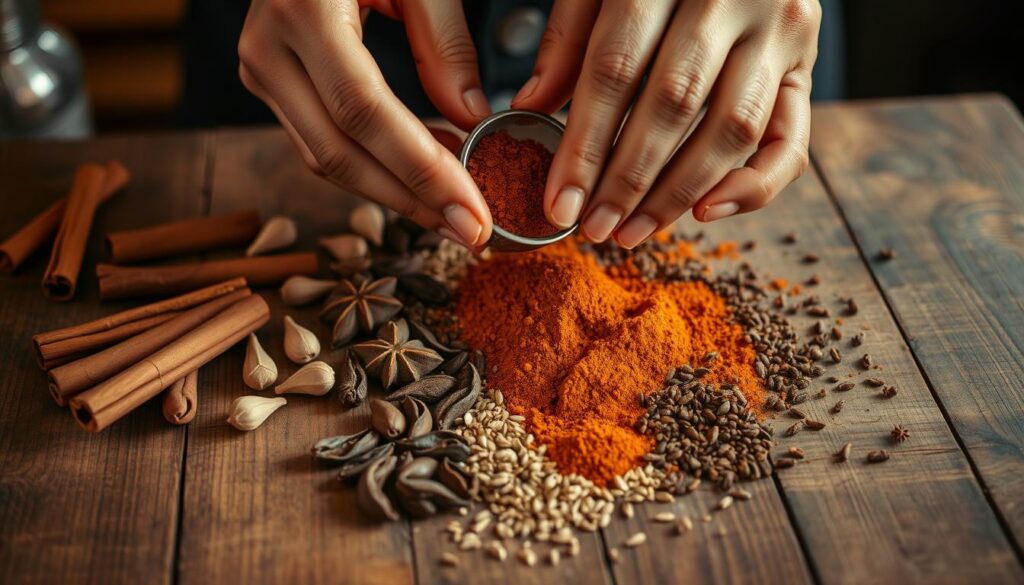
Adjusting Heat and Flavor Notes
Start small. Add an extra teaspoon of cardamom for floral sweetness or reduce cloves by half for milder warmth. “Too much black pepper can overwhelm delicate dishes,” warns Ayurvedic chef Priya Rao. Instead, try these tweaks:
- Boost citrus notes with 1 tbsp extra coriander seeds
- Mellow heat by swapping ¼ tsp cinnamon for nutmeg
- Add fennel seeds (½ tsp) for licorice-like complexity
Grinding matters. A high-speed grinder ensures fine powder consistency, letting flavors meld seamlessly. Test new ratios in 5-minute increments—toss a pinch into rice or yogurt to gauge impact. One reader shared: “Cutting cloves by 30% made my lentil soup more family-friendly!”
For dietary needs, omit chili-based spices entirely. Replace them with roasted cumin or turmeric for gentle warmth. Store variations in labeled jars—you’ll want to recreate that perfect signature blend for taco nights or curry feasts!
How to Store and Maintain Freshness of Garam Masala
Ever opened a spice jar only to find its aroma faded? Proper storage keeps your blends vibrant. Oxygen, light, and humidity are flavor thieves—they break down essential oils that give spices their punch. Follow these simple methods to lock in warmth and complexity.
Proper Storage Techniques for Longevity
Glass jars with tight seals are your best allies. Plastic absorbs odors, while metal can react with spice oils. Store your mix in a dark pantry away from stoves or windows. In humid climates, refrigerate or freeze portions in small containers.
| Storage Method | Shelf Life | Best For |
|---|---|---|
| Pantry (cool/dry) | 3-4 months | Frequent use |
| Refrigerator | 6 months | Humid areas |
| Freezer | 1 year | Bulk batches |
Label containers with dates to track freshness. “If your blend smells flat, it’s time to make a new batch,” advises spice expert Raj Mehta. A single tablespoon packs just 15 calories but delivers bold flavor without added fats—perfect for low-sodium diets.
For peak potency, grind whole spices as needed. Pre-ground versions lose zest faster. Keep jars closed until ready to use—even 10 minutes of exposure to steam can clump fine powder. Your future curries will thank you!
Conclusion
Your kitchen adventures just got a flavorful upgrade. Crafting homemade garam masala isn’t just about mixing spices—it’s a gateway to richer, healthier meals rooted in centuries of tradition. By toasting coriander, cumin, and cloves, you create a blend that outshines store-bought versions in both aroma and taste.
Remember: Small tweaks make it yours. Adjust the heat with extra cinnamon or dial back cloves for milder warmth. Store your mix in airtight jars to preserve its vibrancy for soups, grilled meats, or even baked goods. One batch yields enough for 15+ servings, making it a pantry staple.
Ready to experiment? Toss a pinch into scrambled eggs or dust it over popcorn. Share your creations online—we’d love to hear how this versatile recipe transforms your go-to dishes. Every sprinkle honors its rich cultural legacy while adding modern flair to your table.
Now grab those spices and start blending. Your taste buds—and dinner guests—will thank you!
FAQ
Can I substitute store-bought curry powder for garam masala?
While both are spice blends, they differ in flavor. Curry powder often includes turmeric and has a milder taste. For authentic depth, use the traditional blend or adjust recipes by adding warming spices like cinnamon or cloves.
How long does homemade garam masala stay fresh?
Stored in an airtight container away from heat and light, it retains peak flavor for 2–3 months. For maximum aroma, grind whole spices in small batches every 4–6 weeks.
Can I adjust the heat level in this spice mix?
Absolutely! Control the kick by tweaking black pepper or dried chili amounts. For smoky notes, add a pinch of toasted cumin or paprika. Balance sweetness with cardamom or nutmeg.
Is garam masala gluten-free and vegan-friendly?
Yes! Pure blends contain only spices, making them suitable for most diets. Always check labels for additives if using pre-made mixes from stores like McCormick or Everest.
What’s the best way to use this blend in non-Indian dishes?
Sprinkle it on roasted veggies, mix into burger patties, or stir into soups. Its warmth pairs well with fall recipes—try adding a pinch to pumpkin pie filling or apple crisps.
Do I need special equipment to make it at home?
A coffee grinder or high-speed blender works for grinding. For even roasting, use a heavy skillet like cast iron. No tools? Pre-ground spices can be mixed, though whole spices offer richer flavor.
Are there health benefits to using this spice blend?
Many ingredients, like cumin and coriander, aid digestion. Cloves and cinnamon contain antioxidants. However, enjoy it primarily for flavor—nutritional impact per serving is minimal.

